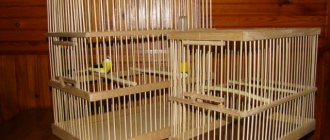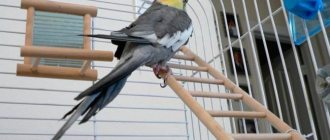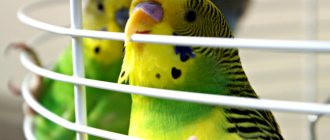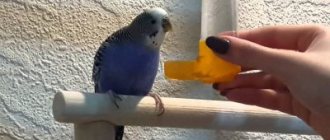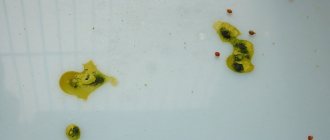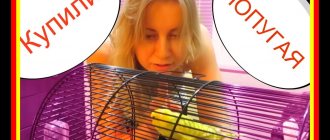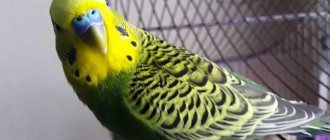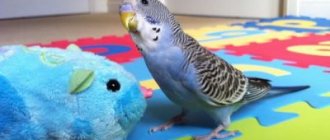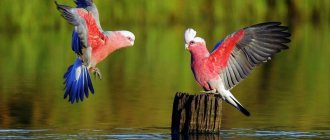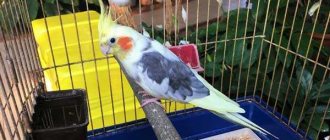All birds that are brought into captivity need special care and cleanliness. If the owner of the bird neglects cleanliness and hygiene, the pet may simply get sick, and it may also develop various parasites, which can cause death if everything is too severe.
In addition to the fact that the cage needs to be washed every day, after the old bedding is removed and a new one is placed after washing, it is also necessary to thoroughly rinse the feeders and keep them clean. It is not recommended to use newspapers or magazines as bedding material, as ink can get on your pet's paws and this can cause some diseases.
Cleaning
To make daily cleaning of the cage simple, it is best to stock up on some products:
4. laundry soap;
5. infusion of wormwood or chamomile;
6. baking soda.
When a pet just appears in the house, you need to immediately take care of its health. A new cage must be washed thoroughly immediately before use, even if it looks perfect and completely clean. General cleaning of the bird house should be done every week and at least less often. Parrots are very active birds, which in 7 days can turn a cage into a real warehouse for all kinds of garbage.
How to wash the cage is up to each person to decide for himself, but if it is small in size, then it can be taken to the bath and put in proper shape there. Using a shower can greatly simplify the process of cleaning the cage.
If the cage is quite large and cannot fit in the bathroom, then you can simply wash it in the room, first covering the table or floor with film or plastic oilcloth.
How can you clean a cage well?
Before cleaning, you need to remove all things and toys from the cage. A grid, tray, feeder, perch are things that any bird needs for a normal life, but they need to be washed separately, and not together with the cage.
To wash the tap hole, you can use regular soda or laundry soap. Using a brush, you can wash your pet’s house very quickly and easily. After the cage is washed, you need to pour hot water over it and place it in a convenient place to dry.
If you can wash the cage in the bathroom, you can use a shower to simplify this task and make it more enjoyable and quick. For washing, you can use a shower, as well as a brush and soap. You need to put a rubber mat on the bottom of the bathtub, but if you don’t have one at hand, then you can use an ordinary towel so as not to scratch the enamel on the bathtub.
Cleaning a bathtub in a room is much more difficult. You can use a spray bottle to spray the cage with hot water. This must be done so that the remaining droppings fall off along with the remaining food. The next step is to soap a cloth and use it to clean the rods, which need to be carefully scrubbed, and then wipe them with a damp cloth.
Disinfection
In order to disinfect the cage, you should use only those products that do not contain chlorine, since this substance is very dangerous to the health of birds. A solution of potassium permanganate or ordinary chamomile, which can be found in a regular pharmacy, disinfects very well. To improve the effect, you can use everything at the same time. If there is no chamomile in the house, then you can use wormwood.
Before disinfection, it is necessary to dry the cage very well or wipe it with a towel. You need to treat the cell with the prepared solution and rinse it with water or simply wipe it with a damp cloth and dry it. Under no circumstances should traces of disinfectants remain on the cage bars, which are very dangerous to the health of the birds. Potent substances cannot be used very often and are best used when parasites appear.
After the bird's cage has been thoroughly washed, disinfected and dried, all the parts need to be placed in it - a tray, drinkers, feeders. All attributes must be in place, they must be clean and dry.
If moisture remains in some places, it can cause mold, which can cause many diseases in the bird. When the cage is thoroughly washed, cleaned, disinfected and dried, everything needs to be put back in its place and the parrot returned back.
Birds are the most beloved pets that require special attention and proper care. An important measure in the process of keeping them in captivity is the disinfection of the common area and the parrot’s cage.
To get rid of pathogenic microorganisms, specialists have developed special treatment products. Their main goal is not to make things worse, because... feathered friends are very sensitive to chemicals. Therefore, all disinfectants undergo careful testing and selection based on many indicators.
How to properly disinfect a parrot's cage
Why are cells disinfested?
Breeders often wonder why they should disinfect their home. Many people do this to get rid of bad smell. But the house is not cleaned only because of this. Dirt promotes the growth of bacteria and the further development of diseases in parrots.
It is not enough to remove food debris and excrement; it is important to treat the cell with chemicals that destroy the development of pathogenic microflora and interrupt the process of reproduction of infectious parasites.
Experienced owners have developed tips that recommend following:
- Change the paper that is placed on the pallet every day.
- Wash the feeder and drinker thoroughly twice a day.
- Always remove sawdust and sand.
- Carry out wet cleaning on weekends.
Important steps in cleaning a rodent's home
Cleaning a hamster cage begins with the owner removing the animal itself. You need to put him in a safe place so that he doesn’t run away. To do this, use a jar. First, we change the bedding, and do it in such a way as not to destroy the animal’s buildings or to do it to the minimum.
The tray is washed under clean running water. If the contamination is severe, you can use baby detergent or hamster shampoo. You need to be careful with detergents so as not to cause an allergic reaction in the animal.
You need to know how to wash a hamster's cage, sleeping house and dishes: feeder, drinking bowl. The main rule is to do it manually using a brush. After everything is washed, wipe dry. Then we change the bedding. To prevent the rodent smell from disappearing completely, leave some of the old shavings.
Caring for the cage does not end there; you need to wipe the rods with a clean, damp cloth. To ensure that the cleaning is carried out correctly, pay attention to each device, we wipe the wheel, labyrinths, and stairs. Wooden accessories are wiped with a brush, a clean cloth or napkin without using detergents, since the baby chews them. If you decide to clean the cage, be sure to wash the water bowl and fill it with clean water.
What drugs can be used
Chemicals can only be purchased if the breeder knows how to use them correctly. Means that can be used to disinfect bird cages:
- Septabik;
- Avansept;
- Demos;
- Alaminol (quickly kills even mold fungi and tuberculosis pathogens).
These antiseptics are often purchased for general cleaning. It is important to know that they cannot be used on porous objects. But the cage, floor, bars and perches are just right!
After disinfection, everything must be soaked with a damp, clean cloth. And only after 2-3 hours the cage can be used again as a shelter for small birds.
Many people use solutions of calendula, potassium permanganate or soda for disinfection. They are harmless to the body of pets, so immediately after treatment they can be immediately placed in a cage.
Hamster nutritional features
A significant part of the standard diet of a domestic rodent should consist of special food intended for feeding a hamster.
Such ready-made diets can be granulated or presented as seed-based mixtures, which allows you to fully provide your pet with the nutritional components necessary for full growth and development. It must be remembered that, regardless of the breed, hamsters are extremely difficult to tolerate any significant changes in their diet, so it is recommended to constantly purchase the same, but well-balanced and complete food. The transition to another type of nutrition is carried out very smoothly, over several weeks. Beans, onions, potatoes, rhubarb and tomato tops, as well as chocolate and any candies, spices and pickles are strictly contraindicated for pets.
Among the healthiest foods for a domestic rodent are vegetable crops such as turnips, carrots, chicory, spinach, parsley, pumpkin, endive and cauliflower.
Broccoli, green beans and asparagus, raisins, apples and pears, plums and peaches also have a positive effect on your hamster's health. To maintain teeth in good condition and supply the rodent’s body with all the necessary components, it is recommended to use special mineral blocks. Also, special drinking bowls must be installed in the cage, which are regularly filled with clean water.
Pre-cleaning instructions
Before removing parasitic microorganisms, the enclosure should be cleared of feathers, food residues, and excrement. It is recommended to get rid of small structural particles, dirt coating and stuck together components.
The first step is to wipe off the top layers of dust. Change the paper for the pallets to a new one, wash the feeders and replace the sand and sawdust. Wash the cage 1-2 times a week, and let the parrots fly. Rinse all pet toys in clean water. Only after everything in the house is dry can you proceed to disinfection.
How to disinfest a bird's home
To remove pathogenic flora, breeders need to use 3 bowls:
- pour the detergent solution into the first one;
- second - antiseptic;
- in the third - clean water for rinsing.
Rinse each item in them one by one, after removing dried dirt. Keep in the disinfectant for at least 30 minutes.
After thorough cleaning, sterilize to prevent the development of diseases. To complete the process, experts advise leaving all objects and bird toys in an antiseptic solution overnight.
News:
To provide emergency care and receive quality advice, you must fill out a medical history template!
Attention! Due to the temporary absence of specialists in the “disease” section, we provide only first (emergency) assistance. We apologize for the inconvenience, administration of the site volnistiki.info
Author Topic: Disinfection of a budgerigar cage with knemidocoptic mange (mite). (Read 11275 times)
0 Users and 1 Guest are viewing this topic.
Any thematic communities have sections on sales of specialized used goods. Cages, drinkers, bathers, perches... - all this can pose a great DANGER FOR YOUR bird (and you.).
After all, if before you bring a new bird home, you must visit a doctor with it and get all the certificates about infectious diseases, then in the case of goods, feed, equipment, no one requires certificates from birds located or living in the premises where the goods were purchased or animals, people...
Psittacosis, mycobacteriosis, tuberculosis, salmonellosis, helminthiasis and other diseases can simply be brought into the house with goods purchased “from hand”.
The bird flew away, died, or the product simply didn’t fit and was no longer needed - at flea markets you can find a lot of inexpensive, interesting things that you either can’t find or are difficult to find in stores...
How often should you wash your parrot's cage?
There are two types of cage cleaning, and each of them has its own routine and frequency:
- wet cleaning - carried out daily and consists of removing food debris, changing bedding and washing dishes;
- general cleaning - the frequency of this procedure depends on the pet: when large animals (for example, lorikeets) are kept in a cage, this cleaning is carried out every week, but for small birds (for example, budgies), monthly repetitions will be sufficient.
#1 2009-08-31 16:53:54
How to disinfect a wooden cage?
A girl lent me a large wooden cage for my crow. Her bird lived there, but she suddenly died a few days after being moved to a new cage. The cage is large, but before this the crow lived in a cramped one. So I assume that the bird had a stroke or heart attack, because she immediately began to move a lot in the new house, her heart could not stand it out of habit. Unfortunately, the owner's relatives immediately buried the dead crow, so it was not possible to perform an autopsy to know for sure the cause of death.
Before that crow, someone also lived in the cage; it came to me through third hands. The doctor told me that it is best to pour boiling water over the cell, this will kill all the infection. But the cage is so big that it cannot be pulled into the bath. And there is no huge trough to put the cage in and water from the kettle. The floor and walls are wooden, the rest is iron bars.
What to do? If there is a topic where all this is explained, send me a link. I have not found.
Cleaning products
When choosing cleaning products, you should know that even when carrying out general cleaning, you cannot disinfect the cage with strong chemicals that can harm the health of the parrot. Exceptions may be in extreme cases, for example, when parasites are detected.
For daily
For daily cleaning, it is enough to use infusions of chamomile or wormwood as disinfection, which are highly effective and absolutely safe for both poultry and humans. To do this, moisten a napkin in the broth and wipe each corner of the cage. A good remedy is also a soda solution, which can be obtained by stirring 2-3 tsp. soda in a glass of hot water.
For the general
During general cleaning, stronger products may be required. This could be, for example, a disinfestal solution, which, by spraying (you can use a regular syringe), treats the entire cell. After completion, it is thoroughly washed under running water and dried. You can only bring the parrot back after 30 minutes.
You can use simple bleach for the same purposes. To do this, dilute 200 ml of the product in 5 liters of water and wash the entire cage, after which it is left without rinsing for 10 minutes. Only after this is the cage rinsed (special attention should be paid to the wooden parts). During the procedure, it is recommended to use personal protective equipment (goggles, mask, gloves), and open the windows in the room for ventilation.
#4 2009-09-02 14:17:41
Re: How to disinfect a wooden cage?
sili, I looked at the link, thanks. But it still says more about treating the cage just in case it is known for sure that an infected bird has never lived there. Yes, I can wash a fairy cage, it's a good remedy. Only now I thought that it takes a long time to wash off, I know from the dishes. Is it okay that it is not possible to put the cage under water? We had an idea - what if we treated the cage with steam from an iron? You know, how clothes are steamed by weight, a special device. We have it. Will this work? If in combination with fairies.
How to wash a cage
Depending on the type of cleaning, its implementation may differ slightly.
So, daily cleaning consists of several stages of cleaning:
- Bedding - The bedding, which is usually black-printed newspaper sheets (dye of a different color can be toxic), on the bottom of the cage needs to be changed every day. To make the task easier, many owners lay out the bottom in several layers at once and simply remove the top sheet every day. However, in this case, you should make sure that the rest of the paper is not stained.
- Utensils such as a feeder and a sippy cup also require daily washing with hot water and soap. At the same time, many owners use a dishwasher without household chemicals or a disinfectant. It is important to make sure that the feeder is completely dry before installing it, since mold can form on the feed (whether it is raw material or pellets) if it gets damp. The best option is to have two sets of dishes at once - if the first one needs to be washed and dried, put the second one. In this case, it is best to use utensils made of stainless steel or hard plastic - each of these materials is easy to clean and withstands the effects of hot water and additional disinfectants. Daily washing of the feeder allows you to understand whether the feeding rate has been chosen correctly; if there are frequent leftovers of food, the portions should be reduced somewhat.
- Equipment and areas around the cage - all accessories should be thoroughly washed daily. For example, don’t just change the water in a bathtub, but first wash it with hot water and soap or a disinfectant. Clean the perch and toys from adhering droppings. You should also sweep the area around the cage to remove debris, feathers, and grains. An assistant in this matter can be a special pallet, which you just need to shake out.
In addition to daily cleaning, general cleaning should also be carried out.
Conventionally, the entire process of general cleaning can be divided into several main stages:
- Preparation of inventory. You will need: fresh bedding, paper napkins, rags, a special disinfectant, sandpaper, brushes. It is better if everything is in one place, for example, in a plastic container specially purchased for this purpose.
- Removing the bird to a safe place. The optimal solution would be to transplant the parrot into a second cage and move it to another room. Such actions will protect the bird from toxic fumes of cleaning products. In addition, it is necessary to remove all equipment and toys from the cage.
- Cleaning and washing the cage. After removing bedding, remaining food and droppings, the cage should be thoroughly washed under hot water and soap, then rinsed with warm water and treated with a disinfectant. Many people install it directly in the bath or shower for these purposes. After another rinse, the cage should be thoroughly dried. Next, you need to wash all the toys (if they are made of material or ropes, washing is allowed) and the perch with regular dishwashing detergent (adhered droppings can be removed with sandpaper). This is followed by treatment with a disinfectant, rinsing in clean water and drying thoroughly (preferably in the open air). All broken accessories should be thrown away.
- Cleaning the tray. After pieces of food and droppings have been removed from it, the tray must be washed, disinfected and dried. Additionally, you need to pay attention to the surface underneath, as well as nearby walls, where food residues may stick.
- Completion of the procedure. The cage is put back in place, dishes, equipment and toys are returned, and new bedding is laid. You need to put a new portion of food in the feeder, and pour fresh water into the sippy cup. After all the manipulations, the parrot can be returned to its original place.
#2 2009-09-01 08:28:14
Re: How to disinfect a wooden cage?
Miss Snork writes:
Her bird lived with us, but she suddenly died a few days after being moved to a new cage. The cage is large, but before this the crow lived in a cramped one. So I assume that the bird had a stroke or heart attack, because she immediately began to move a lot in the new house, her heart could not stand it out of habit.
Miss Snork , good morning.
This option is extremely unlikely, not to say fantastic. I'm afraid that scalding with boiling water is a method for clearing one's conscience. Few things die directly from scalding - microorganisms have spores and cysts.
In general, I would never take a wooden cage where birds had previously died due to unknown circumstances.
To begin with, the wooden parts must be thoroughly cleaned, sanded and any debris removed. The next option for processing is a blowtorch or a high-temperature construction hair dryer . The lamp is better. Of course, it will burn the wood somewhat, but it will be even more beautiful. But it can burn both wooden and iron parts, but you just have to not miss a corner. It will definitely kill everything.))) Then you can treat the wood with water-based varnish and the cage will be as good as new.
How often should you wash your parrot's cage?
There are two types of cage cleaning, and each of them has its own routine and frequency:
- wet cleaning - carried out daily and consists of removing food debris, changing bedding and washing dishes;
- general cleaning - the frequency of this procedure depends on the pet: when large animals (for example, lorikeets) are kept in a cage, this cleaning is carried out every week, but for small birds (for example, budgies), monthly repetitions will be sufficient.
Nutrients
Proteins.
In addition to carbon, hydrogen and oxygen, protein feed also contains nitrogen, carbon, sulfur, phosphorus, iron, various amino acids and proteins. The latter, compared to other groups of nutrients, occupy a special place in the diet of parrots, since they cannot be replaced by fats and carbohydrates.
Proteins are part of all organs and tissues in the bird’s body and therefore are an essential nutrient.
There are proteins of plant and animal origin.
Carbohydrates.
Carbohydrates that birds receive from feed provide energy for various physiological processes occurring in the body. Carbohydrates include fiber and nitrogen-free extractives. As you know, fiber is the main component of cell membranes in body tissues. All plant foods are rich in fiber to a greater or lesser extent.
Fats and carbohydrates do not contain nitrogen. Since they contain only carbon, hydrogen and oxygen, they are called nitrogen-free substances.
Nitrogen-free extractives include starch and various sugars. Carbohydrates included in this group are well absorbed by the body of birds and have high nutritional value.
Fats provide more than two times more energy than proteins and carbohydrates, are part of the protoplasm and play an important role in cellular metabolism, being an important component of the parrots’ diet.
The fat content in different feeds varies within very wide limits. For example, wheat and rye seeds contain no more than 2%, and oats and corn contain about 6%. The most fat is found in sunflower and flax seeds (30–40%).
Organic compounds called vitamins are vital for the parrot's body. A lack of vitamins leads to a decrease in the viability and resistance of the bird’s body, and also negatively affects its reproductive abilities.
Not all lovers of exotic birds know that the appearance of symptoms of vitamin deficiency in parrots can be caused by the action of antivitamins, which are compounds similar in structure to vitamins, but suppress the function of the latter or completely displace them. A large number of antivitamins are contained in the B vitamin group.
When feeding a parrot with grain mixtures from domestic producers, it is necessary, in addition to the main food, to give the bird vitamins.
Depending on their ability to dissolve, vitamins are divided into fat-soluble (A, D, E, K) and water-soluble (B, C). And depending on the effect, in addition to vitamins (A, D, E, C), which perform the functions of forming and maintaining the structural integument in a normal state, there is a group of vitamins (B, K), which act mainly as coenzymes.
The need for vitamins is different for each individual, so any bird owner sooner or later faces the question: what vitamins and how much should his pet consume daily.
The composition and amount of vitamins that a bird should receive largely depend on the state of its body, as well as on the conditions of its maintenance and feed ration.
If it is difficult to determine how many and what vitamins a pet needs at a certain time, then you need to familiarize yourself with certain rules for taking vitamins by your parrot in various situations.
When feeding a bird with grain mixtures, it is necessary to give it a multivitamin preparation 1–2 times a week in the amount specified by the manufacturer. When hatching eggs and molting, it is advisable to increase the dose of vitamins. In addition, during preparation for the period of incubation of eggs, it is necessary to give the female additional vitamin E before laying the first egg.
It is quite difficult to give a parrot vitamins if it suffers from indigestion. Even when consuming fortified food, the bird will still suffer from a lack of vitamins, which will not only not contribute to its recovery, but will also further aggravate the painful condition of its body. Therefore, in case of intestinal disorders, it is necessary to significantly increase the dose of vitamins.
Antibiotics strongly absorb vitamins. Therefore, treating birds with the use of such medications involves simultaneous administration of an increased dose of vitamins.
Under no circumstances should you calculate a parrot's daily vitamin intake based on the bird's total weight.
We invite you to familiarize yourself with Key cells in a smear in women: normal
As vitamin supplements, you can use special fortified mixtures of domestic or imported production. For example, almost all pet stores sell food for different types of parrots, treated with a special fortified composition.
It is advisable for every parrot owner to know what types of food contain the vitamins necessary for birds.
Vitamin A (retinol), which is synthesized in the liver of birds from carotene, is necessary for parrots to grow, improve reproductive functions, normal functioning of the nervous system and good vision. Carotene is found mainly in foods of plant origin (carrots, greens, grass and pine flour), as well as in foods of animal origin (fish oil, egg yolk).
Vitamin D (calciferol) is involved in phosphorus-calcium metabolism in the body of birds, ensures normal growth and development of bones, and the formation of egg shells. Vitamin D is synthesized in the skin of birds under the influence of ultraviolet rays and is found in fish oil.
Vitamin E (tocopherol) is essential for parrots to have normal reproductive activity. Tocopherol is found in sprouted grains, green food, boiled eggs and milk.
With varied feeding, the parrots' body usually does not lack most B vitamins. However, during molting, illness, or feeding chicks, synthetic preparations of vitamins of this group should be introduced into the bird's diet.
Vitamin K (phylloquinone) promotes normal blood clotting. Cabbage, nettle, spinach, as well as green parts of plants are rich in vitamin K.
The normal process of protein and carbohydrate metabolism in the poultry body depends on vitamin B1 (thiamine). Thiamine is found in grain feed, as well as in brewer's yeast and young plant sprouts.
Vitamin B 2 (riboflavin) is part of enzymes that regulate oxidative processes in cells. In addition, riboflavin is involved in carbohydrate, protein and fat metabolism. Of all feeds, the richest in vitamin B2 are sprouted grains, greens, dairy products, as well as feed and brewer's yeast.
Vitamin B 3 (nicotinic acid) is involved in the synthesis of fats and proteins and affects growth, plumage, skin tissue and the functioning of the nervous system. Nicotinic acid is found in yeast, alfalfa flour, milk powder and wheat bran.
Vitamin B5 (nicotinic acid) has an effect on the general metabolism in the body of parrots. Vitamin B5 is found in sprouted grains, boiled eggs and liver. A small amount of acid is present in milk.
Vitamin B 6 (pyridoxine) takes an active part in protein metabolism and affects the content of hemoglobin in the blood. In addition, pyridoxine is part of the enzymes involved in the breakdown of amino acids. This vitamin is found in yeast, milk, green plants and chicken eggs.
Vitamin B 9 (folic acid) promotes the normal development of feathers, stimulates and regulates the process of hematopoiesis, preventing anemia. Sources of folic acid include alfalfa meal, various types of grain feed and yeast.
Vitamin B 12 (cyanocobalamin) plays a huge role in the use of animal protein by the poultry body, and is also involved in the metabolism of certain amino acids. It is found in all types of animal feed.
When treating parrots with sulfonamide drugs, it is necessary to include B vitamins in their diet.
Vitamin H (biotin), which affects the reproductive abilities of parrots, as well as fat metabolism and the normal functioning of the skin, is found in cereal grains, yeast, alfalfa flour and skimmed milk powder.
Knemidocoptic mange in parrots, treatment
Knemidocoptes mites are difficult to notice and their size does not exceed 0.4 mm. They feed on the epidermis of birds.
Ticks settle on parts of the parrot's body that are not protected by feathers - the wax, paws, cloaca, and in the area around the eyes. The parasite actively multiplies, creates numerous passages in the skin and causes unbearable itching, the skin becomes porous. This mite is called scabies because of the reaction of the victim: the parrot constantly itches and behaves restlessly.
Most often, a bird reaches its owner already infected from the previous owner if it was kept in unsuitable conditions and had contact with sick relatives. Ticks and their eggs can be carried into the cage along with food and tree branches.
The incubation period of the parasite lasts 4 months. During this period, the symptoms of the disease are practically invisible. If the bird's immune system is in order, knemidocoptosis will occur in a latent form without obvious signs of the disease, but the parrot will become a source of infection for its feathered neighbors.
Any stressful situation, lack of vitamins, poor nutrition and hypothermia will lead to the rapid development of severe lesions:
- feathers will fall out;
- large growths form on the skin;
- the beak will bend.
We invite you to familiarize yourself with Treatment of parasites in the human body: folk remedies
Only timely treatment of knemidotocoptosis in parrots can save the situation. If no measures are taken, the bird will die.
Size
In nature, in their natural habitat, hamsters of all breeds are extremely active and energetic, because their life directly depends on the ability to run quickly: they need to go scouting for new food, collect it and take it to their burrow, simultaneously escaping from a predator.
Pets do not need to do all this, but nature takes its toll and requires that energy be spent moving around the cage; accordingly, the rodent should have enough space for this. In addition, he will need separate areas for toileting, eating, sleeping and storing supplies.
The recommended cage size for keeping one individual is 30x30x45, but more is possible. If you are limited in space, you can take a closer look at two-story options, but young and active animals often fall from the second floor, which can lead to injury.
Cleaning products
When choosing cleaning products, you should know that even when carrying out general cleaning, you cannot disinfect the cage with strong chemicals that can harm the health of the parrot. Exceptions may be in extreme cases, for example, when parasites are detected.
Also find out whether your parrot's cage needs to be covered at night.
For daily
For daily cleaning, it is enough to use infusions of chamomile or wormwood as disinfection, which are highly effective and absolutely safe for both poultry and humans. To do this, moisten a napkin in the broth and wipe each corner of the cage. A good remedy is also a soda solution, which can be obtained by stirring 2-3 tsp. soda in a glass of hot water.
For the general
During general cleaning, stronger products may be required. This could be, for example, a disinfestal solution, which, by spraying (you can use a regular syringe), treats the entire cell. After completion, it is thoroughly washed under running water and dried. You can only bring the parrot back after 30 minutes.
Did you know? The smallest species of parrots live in New Guinea
— their body length barely reaches 8 cm. But the Amazonian ones are considered the largest
-
some individuals exceed the size of a three-year-old child and can be about 1 m in height.
You can use simple bleach for the same purposes. To do this, dilute 200 ml of the product in 5 liters of water and wash the entire cage, after which it is left without rinsing for 10 minutes. Only after this is the cage rinsed (special attention should be paid to the wooden parts). During the procedure, it is recommended to use personal protective equipment (goggles, mask, gloves), and open the windows in the room for ventilation.
#5 2009-09-02 14:38:51
Re: How to disinfect a wooden cage?
Miss Snork, to be honest, in my opinion, Muschen proposed the optimal solution. everything else is assumptions and approximations with all the ensuing consequences. about steam. The density of its release also plays a role here. It’s one thing under pressure from a steam cleaner, another thing from an iron. not an option, in general (IMHO)
try chemical reagents (they are indicated in that topic). and several times in a row increasing the dosage by 1.5 times, spilling cracks and joints, and before and after a lot of boiling water (in buckets)
There is a crazy bird inside every woman. (M. Fry) ". to live between your mind and feelings. " (Scorpions)
I'll disappear for a couple of days and come back.
What cell color to choose
The bars of most cages are powder coated or made of stainless steel. Powder coating means that the metal is spray painted. These parrot cages can be very attractive because owners can choose a cage of any color that matches the design of the apartment and the color of the bird.
However, it is worth understanding that sooner or later you will notice that the paint has peeled off, and you will need to either put up with it or repaint the cage. The best choice is a stainless steel frame. Such cells are durable. However, they are also expensive. However, in the future you will spend less money on their maintenance than on a standard painted house.
We recommend reading: A Cat Vomits and Vomits What to Do
What can you use to make housing for a Djungarian hamster?
You can make housing for a dzhungarik with your own hands. You just need to choose a non-toxic and durable material. The house can be made from:
- wooden planks or planks;
- coconut shells;
- organic glass;
- plastic;
- thick cardboard
A wooden house cannot be varnished or painted, as this will cause poisoning to the hamster. A house made of plastic and organic glass can be more durable and safer.
Has your hamster ever lived in a wooden house?
You can make a cage with your own hands
How to wash a cage
Depending on the type of cleaning, its implementation may differ slightly.
So, daily cleaning consists of several stages of cleaning:
- Bedding - The bedding, which is usually black-printed newspaper sheets (dye of a different color can be toxic), on the bottom of the cage needs to be changed every day. To make the task easier, many owners lay out the bottom in several layers at once and simply remove the top sheet every day. However, in this case, you should make sure that the rest of the paper is not stained.
- Utensils such as a feeder and a sippy cup also require daily washing with hot water and soap. At the same time, many owners use a dishwasher without household chemicals or a disinfectant. It is important to make sure that the feeder is completely dry before installing it, since mold can form on the feed (whether it is raw material or pellets) if it gets damp. The best option is to have two sets of dishes at once - if the first one needs to be washed and dried, put the second one. In this case, it is best to use utensils made of stainless steel or hard plastic - each of these materials is easy to clean and withstands the effects of hot water and additional disinfectants. Daily washing of the feeder allows you to understand whether the feeding rate has been chosen correctly; if there are frequent leftovers of food, the portions should be reduced somewhat.
- Equipment and areas around the cage - all accessories should be thoroughly washed daily. For example, don’t just change the water in a bathtub, but first wash it with hot water and soap or a disinfectant. Clean the perch and toys from adhering droppings. You should also sweep the area around the cage to remove debris, feathers, and grains. An assistant in this matter can be a special pallet, which you just need to shake out.
In addition to daily cleaning, general cleaning should also be carried out.
Conventionally, the entire process of general cleaning can be divided into several main stages:
- Preparation of inventory. You will need: fresh bedding, paper napkins, rags, a special disinfectant, sandpaper, brushes. It is better if everything is in one place, for example, in a plastic container specially purchased for this purpose.
- Removing the bird to a safe place. The optimal solution would be to transplant the parrot into a second cage and move it to another room. Such actions will protect the bird from toxic fumes of cleaning products. In addition, it is necessary to remove all equipment and toys from the cage.
- Cleaning and washing the cage. After removing bedding, remaining food and droppings, the cage should be thoroughly washed under hot water and soap, then rinsed with warm water and treated with a disinfectant. Many people install it directly in the bath or shower for these purposes. After another rinse, the cage should be thoroughly dried. Next, you need to wash all the toys (if they are made of material or ropes, washing is allowed) and the perch with regular dishwashing detergent (adhered droppings can be removed with sandpaper). This is followed by treatment with a disinfectant, rinsing in clean water and drying thoroughly (preferably in the open air). All broken accessories should be thrown away.
- Cleaning the tray. After pieces of food and droppings have been removed from it, the tray must be washed, disinfected and dried. Additionally, you need to pay attention to the surface underneath, as well as nearby walls, where food residues may stick.
- Completion of the procedure. The cage is put back in place, dishes, equipment and toys are returned, and new bedding is laid. You need to put a new portion of food in the feeder, and pour fresh water into the sippy cup. After all the manipulations, the parrot can be returned to its original place.
What can you play with your hamster at home?
If the hamster is not in direct danger or any kind of threat, he is ready for almost any game, especially if it becomes a bright and memorable adventure for him. Such an animal loves to actively explore the area, so games with various objects and obstacles, as well as walks outside the cage, can be entertainment for it. The main thing is to ensure maximum safety for your pet.
What toys can you make for your pet?
Today you can buy specialized play items for pet rodents in almost any pet store. They have a wide range of models, but you can make them yourself from scrap materials. In this case, entertaining the hamster will become an exciting activity for the owner.
The following items will be the easiest to make and most entertaining for the animal:
- wooden slides, ramps and stairs;
- house made of cardboard or plywood;
- chewing toys made from hay, coconut or willow for grinding teeth;
- hanging rings, swings and bridges made of thick rope;
- cardboard tunnels;
- baths with purified river sand.
Important! Hamsters quickly lose interest in toys. Therefore, it is recommended to periodically change game items, including updating their design
Fun in the cage
There are two ways to play with a hamster in a cage: passive and active. In the first case, the cage is supplied with a variety of toys and decorative items. Then the most successful will be a variety of tunnels and houses, equipped with various obstacles, sharpeners, etc. The hamster must independently explore them and find the most hidden corners.
Active games involve human involvement; absolutely any toy or object can be used for this. Using pieces of various treats, the animal should be shown the necessary path through all kinds of obstacles. Wooden and crocheted stairs, bridges and all their combinations, as well as open tunnels, are best suited for this. At the end of such a route, be sure to set a portion of your favorite product, thanks to which the animal will be more willing to get involved in the action.
Outside the cage
Adult hamsters that are fully settled at home can be released from the cage. The easiest way to entertain a rodent is with a walking ball; it will allow him to explore the entire room. At the same time, a hamster in “protection” can be picked up without fear even by small children. The ball is considered the best accessory that allows you to protect your rodent from almost any danger.
If the animal is released in a small pen, you can play with it using a small ball or tennis ball. The hamster actively interacts with almost all objects that it can move. In this case, playing with a ball can become the most fun and sporting activity.
Did you know? Even though hamsters do not like to swim, they are considered good swimmers. Rodents can instantly overcome any water obstacle; to do this, they take air into their cheeks, and then use them as a float to maneuver on the surface of the water.
In the absence of a ball, the rodent can be placed in an open maze made of cardboard or plywood. A variety of dead ends, obstacles, holes and narrow passages will allow the animal to save more than one minute in searching for a way out or a treat. An additional combination of such structures with arches and tubular passages, as well as several open pens, will provide entertainment not only for the animal, but for the whole family.
There is something called tunnel climbing deficiency in domestic rodents. In nature, the animal spends most of its time in underground burrows, so it is definitely recommended to install a transforming tunnel. It must necessarily consist of closed flat, curved and rotating parts connected to open areas at both ends.
Description
Symptoms
Most often, mites can be identified by changes in the area between the wax and beak, the corners of the beak under the feathers and on the bird’s feet. These areas become infected first.
If the paws are affected, the scales rise slightly and small bumps appear on the surface. Lumpy growths constantly increase, causing dermatitis. In later stages, joint inflammation, tissue necrosis, and complete or partial loss of limbs are possible. The parrot will be bothered by itching, he will constantly gnaw his paws and seem to mark time.
When the beak or cere is affected, a characteristic yellow-white coating appears in these areas, which is not characteristic of healthy individuals. Over time, the beak begins to deform and increase in size. In advanced stages, the deformation can become irreversible. The bird will constantly scratch its beak with its paw or on the perches. Later stages are characterized by a coating resembling scale - porous, rough growths.
The areas around the eyes and the cloaca area are subsequently affected.
The disease has a long incubation period, which can last 4 months or more. In some cases, for this reason, it can be difficult to make a diagnosis on time.
Mites will not cause any harm to an absolutely healthy bird. If there are two or more birds in a cage, it may be that the weakest one gets sick, and the rest do not even become infected.
We suggest you read How to support the intestines when taking antibiotics, dysbiosis when taking antibiotics, how to treat dysbiosis, dysbiosis, doctor, probiotics - health news
Never make a diagnosis yourself without the appropriate experience and knowledge. To make an accurate diagnosis, scrapings from the affected areas of the bird are performed in a veterinary clinic by an ornithologist.
Sources
By far the largest number of infected birds are found in pet stores. Typically, pet stores violate most of the rules for keeping parrots, as well as hygiene requirements and nutritional standards.
In addition to pet stores, sources of knemidocoptic mange can be:
- branches brought from the street and not properly processed;
- purchased used cages or accessories that have not been properly treated;
- cheap, low-quality feed;
- frequent stress;
- a disease that already exists in the bird, occurring in a latent form.
In birds with good immunity, the disease can occur in a latent form. With a poor diet, errors in maintenance, and also in combination with other diseases, ticks can begin to actively reproduce.
Prevention
varied, proper, nutritious food; branded, high-quality food; hygiene, daily routine and weekly complete cleaning of the cage; processing new accessories or cages in the correct way; daily flights; daily live communication; no stress; no contact with any birds that have not passed quarantine .
After reading the publication, do not forget:
— press “thumbs up”;
— subscribe to the channel, because every subscriber is very important to us.
- leave a comment.
Although some experts believe that keeping budgerigars in sterile conditions is unacceptable, bird owners still need to spend enough time cleaning the area where their feathered pets live.
Parrots are not the cleanest birds. Leftover food, feathers, droppings, all this pollutes the cage, sticks to the rods and perches, which can ultimately lead to the appearance of parasites and various diseases. An unpleasant smell and a sad bird will not bring joy to anyone.
Parrot cages should be cleaned every day. General cleaning is done every 25-30 days. Disinfection is necessary once every three months. A new, just purchased cage must also be thoroughly washed. It is not enough to simply shake out and rinse water bowls and feeders, because mucus from bird saliva forms on their walls. Every day, everything must be washed with a solution of soda or potassium permanganate, then dried, poured fresh water, and put in food.
- a regular brush (you can also use a toothbrush);
- a solution of baking soda, potassium permanganate or a decoction of chamomile; tincture of wormwood is also suitable;
- spray;
- laundry soap;
- napkins or clean rags.
You can start cleaning your parrot cage by:
- The pet should be transplanted to another place, or released to fly.
- Take out all the things inside and soak them in hot water and soda. Afterwards, wash with soap or soda solution.
- Carefully remove contamination from food debris and droppings. Brushes for cleaning toys, dishes and cages should be different.
- Remove old bedding, clean all corners, rods, and bottom. You should not use scented detergents to avoid harming your pet. It is best to use regular laundry soap.
- Rinse everything well with clean water. If the size of the bird’s home is small, it can be easily washed in the bathroom. You can do this in the room using a spray bottle, after covering the floor.
- Be sure to dry with napkins or just air dry.
How to clean a parrot's cage daily:
- Rinse the pan with hot water.
- Treat the drinking bowl and feeder with a solution of baking soda (three tablespoons per liter of water), rinse and dry.
- Replace the bedding.
How to clean a parrot's cage once a week:
- Remove the pan and wash it in a soapy solution with hot water.
- Clean the bottom thoroughly with a brush.
- Clean all toys, ladders and perches from any remaining droppings, food and feathers with a napkin or clean rag.
Caring for a hamster at home
The basic rules for caring for a hamster are simple and easy to understand. There are few nuances that need to be studied by a person who dreams of purchasing this miniature pet for their home. They are associated with feeding the animal, bathing the animals, and their life rhythm, which depends on the time of year. Hobbyists who want to breed hamsters for sale are required to familiarize themselves with the most important information about the life of newborn babies of this species.
It is advisable to know for sure whether children and other family members are allergic to rodent fur. Review the layout of your living space to see if there is free and accessible space for a cage in the apartment. Talk to your children to see if your heirs are eager to look after the tiny tenant or are negative about this prospect.
What to feed hamsters at home?
Rodents in nature have learned to survive by eating both grain foods and animal products. They subconsciously avoid harmful plants or poisonous insects, avoiding poisoning. In apartments, pet owners are tempted to give their little ones pieces of food from the table in order to please the pet, which sometimes causes irreparable harm to them. When asking what you can feed hamsters at home, be careful; it is advisable to know exactly the foods prohibited for these animals.
Plant foods allowed for hamsters:
- ready-made dry diets for hamsters,
- sprouted grains of oats, wheat, other cereals,
- different types of nuts (hazelnuts, walnuts, peanuts),
- sunflower and pumpkin seeds,
- cherries, gooseberries, blueberries, other berries,
- pieces of vegetables processed in boiling water without salt,
- raw vegetables and fruits,
- peas in pods or grains,
- a small amount of rose hips and celery,
- Jerusalem artichoke fruits,
- dried fruits,
- branches of deciduous trees,
- greenery.
Allowed animal products:
- fermented milk products (cheese, cottage cheese, unsweetened yogurt) with a fat content of up to 1%,
- boiled chicken meat without spices,
- boiled eggs,
- boiled low-fat fish,
- in rare cases, pieces of peeled shrimp,
- worms and insects purchased from pet stores.
Domestic hamsters can easily tolerate care and maintenance at home, but for them there is an extensive list of prohibited foods:
- potato,
- fatty cheeses,
- ready-made bird feed,
- fresh bread,
- acorns,
- red beans,
- brazil nuts,
- any spices,
- fresh milk,
- garlic with onions,
- cabbage causes gas in hamsters,
- muesli,
- fried food,
- tropical fruits,
- honey,
- mushrooms,
- sweet cookies,
- wild-caught insects and bloodworms,
- tulip bulbs,
- chocolates,
- ice cream.
Hibernation of hamsters at home
The hibernation of these pets resembles numbness in appearance, which novice hobbyists often confuse with illness. With the beginning of winter, the life of hamsters at home goes into an economical mode; pets stop reacting to stimuli. The transition to hibernation is facilitated by several factors - a decrease in room temperature, a poor diet, and poor lighting. After being placed in a warm place, rodents will eventually awaken on their own, but it is not recommended to force them to wake up.
How to bathe hamsters at home?
It is recommended to arrange a shower or bath for pets in rare cases, as this procedure causes stress for them. It is advisable to treat animals with water after the appearance of parasites or in case of severe contamination of the fur. When asking how to wash a hamster at home, you need to use shampoos for rodents and moderately warm water, avoiding overheating the body. Carefully remove foam, dry your skin with a hairdryer or towels, hypothermia after a bath causes a cold.
Caring for newborn hamsters
The keeping of hamsters at home during this period changes slightly; the cage is not cleaned for two weeks after birth; the temperature is maintained at 21 °C. You cannot touch the offspring or disturb the nest after birth. The woman in labor is given a balanced protein diet rich in fats; babies begin drinking water at 10-20 days of age. When nursing babies on their own, they are pipetted with a hamster milk substitute or powdered infant formula; in the second week, babies begin to look for food without outside help.

